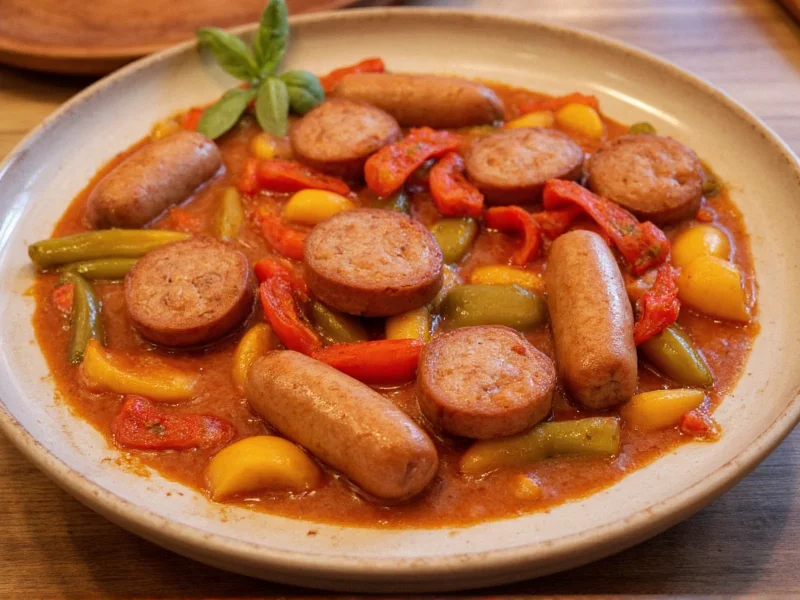Sausage and peppers represents one of America's most beloved Italian-American comfort foods, with roots tracing back to early 20th century immigrant communities. This humble yet flavorful combination showcases how simple ingredients transform through proper technique into something extraordinary. Understanding the balance between quality components and cooking methodology separates an average preparation from an authentic, restaurant-quality experience.
The Essential Components of Authentic Sausage and Peppers
Creating exceptional sausage and peppers requires attention to ingredient selection. The dish's magic happens when quality components work in harmony rather than competing. Traditional preparations use Italian sausage as the protein foundation, but the peppers and onions play equally important supporting roles that contribute both flavor and texture.
Choosing the Right Sausage
Italian sausage comes in two primary varieties: sweet and hot. Sweet Italian sausage contains fennel and black pepper without significant heat, while hot Italian incorporates red pepper flakes for spice. Both work well in this dish, though many enthusiasts prefer a combination of both types for balanced flavor. When selecting sausage, look for:
- Freshly made options from a reputable butcher
- High meat content (at least 70% pork)
- Visible flecks of fennel and other seasonings
- No excessive fillers or binders
| Sausage Type | Flavor Profile | Best For | Cooking Time |
|---|---|---|---|
| Sweet Italian | Mild, fennel-forward | Family dinners, milder palates | 20-25 minutes |
| Hot Italian | Spicy with red pepper flakes | Those preferring heat | 20-25 minutes |
| Tuscan Style | Garlic-heavy, wine-infused | More complex flavor profiles | 25-30 minutes |
Pepper Selection and Preparation
The best peppers for sausage and peppers include a combination of red, yellow, and green bell peppers for both visual appeal and nuanced flavor differences. Red peppers offer sweetness, green provides slight bitterness, and yellow sits between them. Some cooks add banana peppers for tang or cherry peppers for heat. When preparing peppers:
- Remove seeds and white membranes for milder flavor
- Cut into uniform 1/2-inch strips for even cooking
- Consider leaving some pieces larger for texture variation
- Don't discard the flavorful pepper juices that collect
Mastering the Cooking Technique
The traditional stovetop sausage and peppers cooking method follows a specific sequence that maximizes flavor development. Many home cooks make the mistake of cooking everything together from the start, which prevents proper caramelization and leads to steamed rather than sautéed vegetables.
Step-by-Step Preparation Guide
- Prep ingredients: Slice peppers and onions into uniform strips. Remove sausage from casings if desired (though leaving them intact creates attractive presentation).
- Render sausage fat: Brown sausage in a large skillet over medium heat, turning occasionally. Remove when browned but not fully cooked (about 5-7 minutes).
- Sauté vegetables: In the sausage drippings, add peppers and onions. Cook 12-15 minutes until softened but still with some bite, stirring occasionally.
- Combine and simmer: Return sausage to the pan with vegetables. Add 2 minced garlic cloves, 1 teaspoon dried oregano, and salt to taste. Simmer covered for 15-20 minutes.
- Finish: Uncover and cook 5 minutes more to slightly reduce liquid. Adjust seasoning before serving.
Avoiding Common Preparation Mistakes
Many authentic Italian sausage and peppers recipes fail due to preventable errors. Understanding these pitfalls ensures restaurant-quality results every time:
- Overcrowding the pan: Cook in batches if necessary to allow proper browning rather than steaming ingredients
- Incorrect heat level: Medium heat allows gradual flavor development without burning
- Underseasoning: The dish needs adequate salt to balance the natural sweetness of peppers
- Overcooking vegetables: Peppers should retain some texture, not become mushy
- Skipping the resting period: Let the dish sit 5 minutes before serving to allow flavors to meld
Serving Traditions and Modern Variations
Traditional Italian-American sausage and peppers serves as either a standalone meal or part of a larger spread. In New York and other Northeastern cities, it's commonly served on a crusty roll as a sandwich, while in other regions it appears as a plated dinner with sides. Understanding these serving traditions helps honor the dish's heritage while allowing for creative adaptations.
Classic Serving Methods
The most authentic way to enjoy sausage and peppers follows regional Italian-American traditions:
- As a sandwich: On a hoagie roll with optional melted provolone cheese
- Over pasta: Tossed with penne or rigatoni for a heartier meal
- Plated dinner: With a side of roasted potatoes and a simple green salad
- Appetizer style: Served in small portions with crusty bread for dipping
Dietary Adaptations and Creative Twists
Modern interpretations of this classic dish accommodate various dietary needs while maintaining its essential character. When modifying the traditional sausage and peppers recipe:
- For gluten-free diets, serve over polenta or with gluten-free bread
- For lower sodium versions, use low-sodium sausage and increase herbs for flavor
- For vegetarian adaptations, substitute plant-based sausage alternatives
- Add wine deglazing (1/4 cup dry white wine) for enhanced complexity
- Incorporate fresh herbs like basil or parsley at the end for brightness
Storage and Reheating Best Practices
One advantage of this easy sausage and peppers for dinner recipe is its excellent flavor development over time. Proper storage maintains quality while allowing flavors to deepen:
- Store in airtight container in refrigerator for up to 4 days
- Freeze portions for up to 3 months (thaw overnight before reheating)
- Reheat gently on stove over medium-low heat with a splash of water
- Avoid microwave reheating which can make peppers rubbery
- Add fresh herbs after reheating to refresh flavors
Many find that the second-day sausage and peppers tastes even better than freshly made, as the flavors continue to meld during storage. This makes it an excellent meal-prep option for busy weeks.











 浙公网安备
33010002000092号
浙公网安备
33010002000092号 浙B2-20120091-4
浙B2-20120091-4